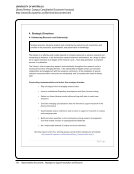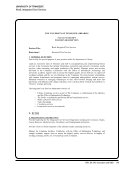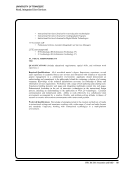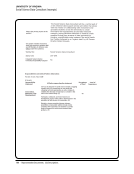SPEC Kit 339: Innovation and R&D · 13
from another source. Examples of other sources of in-
spiration include user suggestions, collaboration with
other campus units, collaboration between library
units, librarians working with faculty, listservs, and
other campus contacts.
When asked what forces were the impetus for the
innovative activity, most of the respondents (37 or
84%) cited the opportunity to further a library or in-
stitutional mission. A substantial number (27 or 61%)
cited user expectations as the driver. Slightly more
than a quarter of the respondents (12 or 27%) indicated
that competition for resources also played a part in
the decision to support the innovation. A number (6
or 14%) indicated that the innovative activity was sup-
ported by a new source of funding while three of the
libraries (7%) innovated as the result of a reduction in
funding. Respondents cited a number of other driv-
ers for the innovation in 29 of the cases (66%). Some
examples of the other drivers include:
• Raising the visibility of the library’s pro-
grams and services in the institution.
• Supporting an already-innovative library
staff culture.
• Needing a comprehensive solution to digital
preservation challenges.
• Having an opportunity to envision and
design a new library from the ground up.
• User expectations.
Library Innovation: Leadership and Structure
The survey further explored the leadership and orga-
nizational structure that exists in libraries to support
innovation. Respondents were asked to identify the
position(s) and/or the unit in the library that is/was
administratively responsible for initiating the example
of innovation described in the case study. The majority
of respondents noted that the library administration
was administratively responsible for initiating the
innovative activity: six listed the university librarian/
dean as the initiator 19 listed an associate/assistant
dean/director. Eight unit or department heads, seven
front-line professionals, and one innovation officer
initiated other innovative activities described in the
case study.
Not surprisingly, the areas that were listed as ad-
ministratively responsible for starting the innovative
activity include library administration (18), a branch
library or center within the library (6), IT (5), tech-
nical services (5), public services (3), special collec-
tions (3), and a team or committee (1). Many of the
responses listed additional roles and units that were
engaged with an administrator in initiating the activ-
ity. Further, a number of initiatives included person-
nel from multiple units (e.g., instructional services
and digital initiatives). This is an indicator that there
is a reasonable level of team involvement and input
in most of the responding libraries in establishing
innovative activities.
Moving deeper into understanding how innova-
tion is accomplished, respondents were asked to in-
dicate the positions and the units at their institutions
that are/were responsible for implementing the inno-
vative activity that was articulated in the case study.
Twenty-one respondents (51%) identified a specific
library unit, 17 (42%) listed a committee or group of
units, and two listed library administration. Examples
of position titles listed in groups or committees in-
clude the following:
• Librarians or IT professionals with web
development and content responsibilities
• Scholarly communications librarian
• Digital learning librarian
• GIS specialist
• Visualization Research Coordinator
• Access services manager
• Digital collections librarian
Perhaps most interesting are the collaborations
put in place to support innovative activities that re-
quire individuals with different skill sets in order to
complete work successfully. Examples of collaborators
include:
• Archives &Special Collections, Web
Resources, Office of Libraries Technology
• IT, User Experience, Digital Library
Initiatives, Engineering Services
• Publishing and Curation Services in the
library and Digital Library Technologies in
the university IT unit.
When asked whether the library provided admin-
istrative support for the individual(s) or unit(s) who
are/were responsible for implementing the innova-
tive activity, the overwhelming majority (32 or 74%)
from another source. Examples of other sources of in-
spiration include user suggestions, collaboration with
other campus units, collaboration between library
units, librarians working with faculty, listservs, and
other campus contacts.
When asked what forces were the impetus for the
innovative activity, most of the respondents (37 or
84%) cited the opportunity to further a library or in-
stitutional mission. A substantial number (27 or 61%)
cited user expectations as the driver. Slightly more
than a quarter of the respondents (12 or 27%) indicated
that competition for resources also played a part in
the decision to support the innovation. A number (6
or 14%) indicated that the innovative activity was sup-
ported by a new source of funding while three of the
libraries (7%) innovated as the result of a reduction in
funding. Respondents cited a number of other driv-
ers for the innovation in 29 of the cases (66%). Some
examples of the other drivers include:
• Raising the visibility of the library’s pro-
grams and services in the institution.
• Supporting an already-innovative library
staff culture.
• Needing a comprehensive solution to digital
preservation challenges.
• Having an opportunity to envision and
design a new library from the ground up.
• User expectations.
Library Innovation: Leadership and Structure
The survey further explored the leadership and orga-
nizational structure that exists in libraries to support
innovation. Respondents were asked to identify the
position(s) and/or the unit in the library that is/was
administratively responsible for initiating the example
of innovation described in the case study. The majority
of respondents noted that the library administration
was administratively responsible for initiating the
innovative activity: six listed the university librarian/
dean as the initiator 19 listed an associate/assistant
dean/director. Eight unit or department heads, seven
front-line professionals, and one innovation officer
initiated other innovative activities described in the
case study.
Not surprisingly, the areas that were listed as ad-
ministratively responsible for starting the innovative
activity include library administration (18), a branch
library or center within the library (6), IT (5), tech-
nical services (5), public services (3), special collec-
tions (3), and a team or committee (1). Many of the
responses listed additional roles and units that were
engaged with an administrator in initiating the activ-
ity. Further, a number of initiatives included person-
nel from multiple units (e.g., instructional services
and digital initiatives). This is an indicator that there
is a reasonable level of team involvement and input
in most of the responding libraries in establishing
innovative activities.
Moving deeper into understanding how innova-
tion is accomplished, respondents were asked to in-
dicate the positions and the units at their institutions
that are/were responsible for implementing the inno-
vative activity that was articulated in the case study.
Twenty-one respondents (51%) identified a specific
library unit, 17 (42%) listed a committee or group of
units, and two listed library administration. Examples
of position titles listed in groups or committees in-
clude the following:
• Librarians or IT professionals with web
development and content responsibilities
• Scholarly communications librarian
• Digital learning librarian
• GIS specialist
• Visualization Research Coordinator
• Access services manager
• Digital collections librarian
Perhaps most interesting are the collaborations
put in place to support innovative activities that re-
quire individuals with different skill sets in order to
complete work successfully. Examples of collaborators
include:
• Archives &Special Collections, Web
Resources, Office of Libraries Technology
• IT, User Experience, Digital Library
Initiatives, Engineering Services
• Publishing and Curation Services in the
library and Digital Library Technologies in
the university IT unit.
When asked whether the library provided admin-
istrative support for the individual(s) or unit(s) who
are/were responsible for implementing the innova-
tive activity, the overwhelming majority (32 or 74%)
































































































































































































